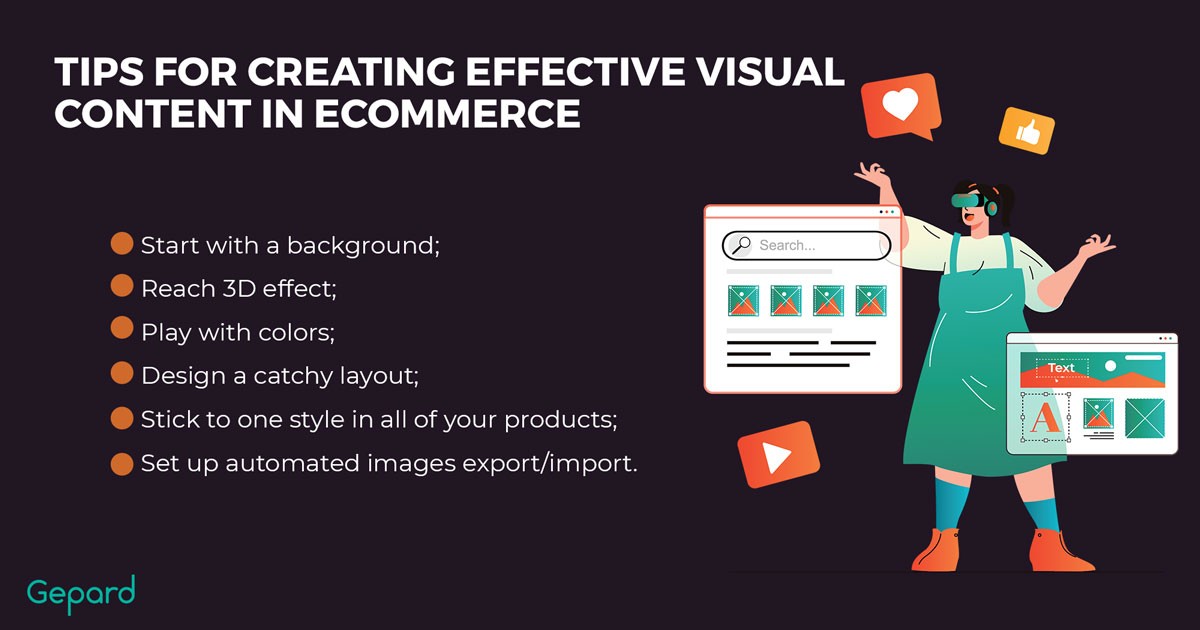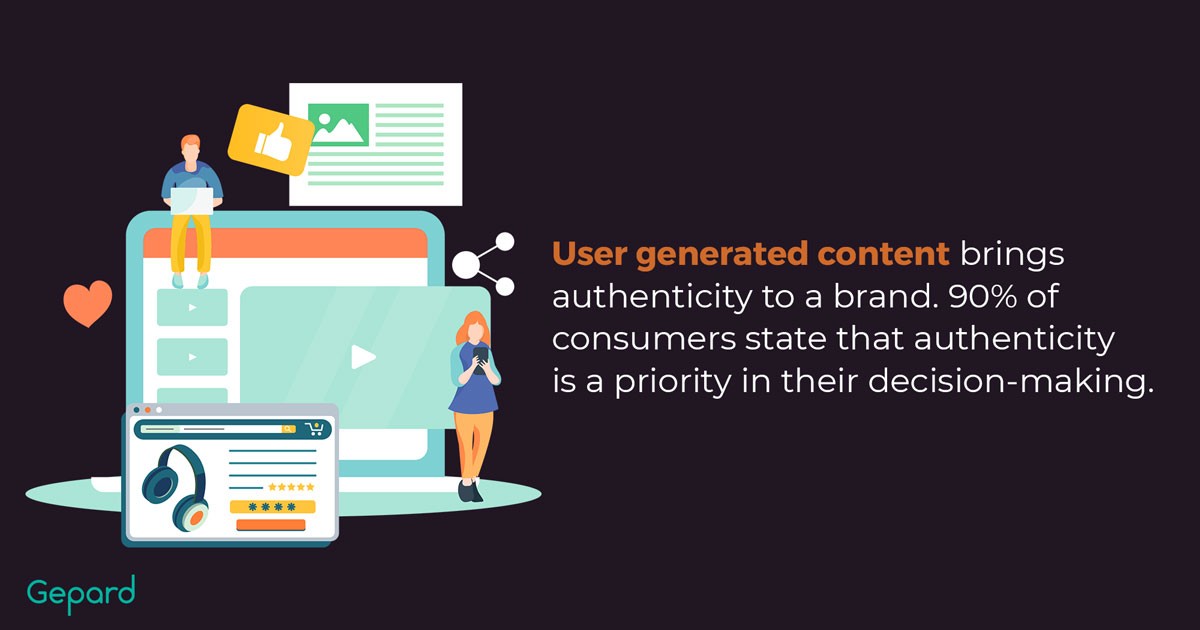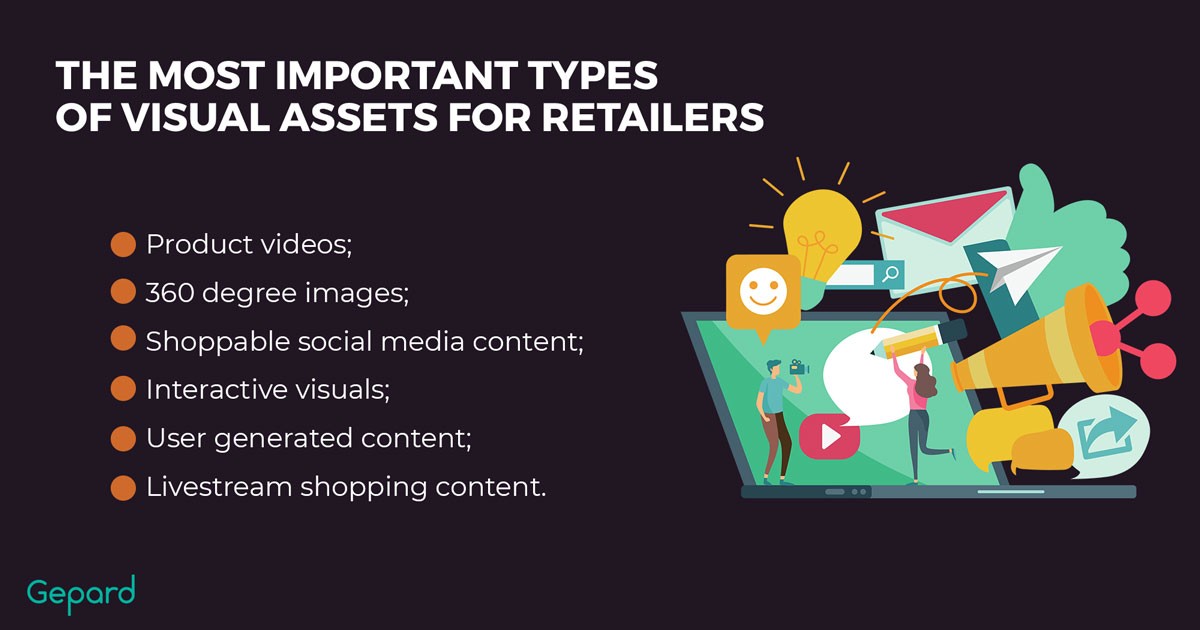Importance of Visual Content: Ultimate Guide for Retailers
We are experiencing an era of high-paced content consumption. Visual content is really what grabs the most attention and delivers the best results. Consumers today don’t go window shopping at their local mall. They browse the web instead. A great product presentation online for customers to view is a good picture or video that is properly advertised.
For online retailers, the importance of visual content is tremendous. Such content allows them to not only present their product but also to increase consumer engagement. That ultimately drives more sales. How to use product visual content efficiently to grab a fair share of the retail market? Keep reading to find all the ins and outs of visual content for online stores.
What Is Visual Content
Visual content marketing is not something new. It has been around for over a century. The best early visual content examples are the 1890s vintage Coca-Cola posters promoting the drink and the brand. Today it’s the same concept when it comes to visual content marketing: technology has changed and so has the market reach. However, the fundamentals remain the same: bring out potential customers’ emotions with the help of imagery.
When it comes to visual content strategy, it’s crucial to have a clear goal you want to achieve. Whether it’s to educate your potential consumers, promote your brand or generate leads, visual content can help you achieve that. Once a goal is set, you need to decide on the distribution channel. The decision should be made based on who your ideal client is and an analysis of the type of social media platforms they use. Once those aspects are determined, plan out and prepare the creative part of the campaign.
Types of Visual Content
What are the most important types of visual content and how to get the most out of them? Here are some of the trendiest visual elements along with examples and practical tips for your eCommerce business.
Infographics
Infographics are designed specifically for people with shorter spans. This group of people doesn’t bother reading long descriptions or blogs. However, as a seller, you need to make sure that such people are fully aware of the salient features of your product. Infographics allow you to do so. With the help of imagery and attractive design, you will be able to grab the attention of people with a shorter attention span. Once you capture their attention, the text on an infographic can convey your message effectively.
Carousels
It is a rather new type of content, but it is really effective, especially for people who want to see pictures and text side by side. Carousels allow you to present your product from various angles and tell buyers about the details of the product at once. If you haven’t used this type of content on your eCommerce website yet, give it a go!
Product Videos
Product videos are means of engagement that bring tremendous value to a brand. This type of visual content production can be a barrier due to its high cost, but the numbers show that consumers place great faith in this type of promotion. While photos and graphics sell a product, the narratives and metaphors of a video leave a lasting impression on the consumer.
Demonstrations and explainer videos are two of the most recognizable product videos. Each provides insight and unpacks product features or particular concepts. Testimonials or company culture videos go further and create brand loyalty and establish trust.
Statistics show that engagement with product videos drives conversions. Some 73% of top online retailers leverage product videos as part of their marketing strategies. The type of product video a company needs depends on the product itself. Additionally, factors like the target audience and the available company resources play a role.
Static product images
These are the most basic visual content that any retailer needs. No matter the type of product, an online shop needs to have static product images. They need to demonstrate the product and at the same time project the brand style.
It goes without saying, a quality product image has to be in high resolution, and of course, it should relate to the accurate colors of the product. Additionally, it’s crucial to display your product in use.
Each eCommerce platform has its own image specifications. If you’re a retailer and constantly need to look up the requirements in different places, to save you the headache we made this cheat sheet. It conveniently breaks down all of the sizes, file formats, background colors, and more for online images.
When preparing your images, keep in mind that this is what shoppers will see not only in your online store.

The visual content will be in ads, search engine results, automated product recommendation emails, etc. For this reason, adhering to the given best practices is extremely important:
1. Start with a background;
2. Reach 3D effect;
3. Play with colors;
4. Design a catchy layout;
5. Stick to one style in all of your products;
6. Set up automated image export/import.
360° Images
A 360-degree image is highly engaging visual content that allows the user to control the image by rotating it 360° from the original point that the picture was taken. Having such visual formats in your online shop adds value to product presentation and raises buyers’ confidence. What is even more important is that it can reduce returns and cut logistical costs.
With that being said, any visual content creation process is complicated. Creating 360-degree images is not the exception, but it’s definitely worth the trouble. It’s important to have higher angles to grab more details from the top. You will need the right equipment to make such images. Once the images are made, their format needs to be mobile-friendly. So far global mobile retail revenue amounted to 3.5 billion USD in 2021. A technical error where your product is not visible is a recipe for disaster. To avoid potential mistakes, hiring a professional agency that creates such visual content is best.
Best Tips For Using Images
Images play an essential role when it comes to enticing digital buyers to purchase. Therefore, you need to make sure that you are using images in the best way possible on your website. Here are some tips and tricks regarding the use of images on your eCommerce website.
- Multiple Angles To Showcase Your Product
Showcasing your products from multiple angles is necessary for eCommerce sales. The reason is they can view and feel the product without any restrictions while purchasing. You can place multiple images of a product that capture the view of a particular product from various angles.
- No Duplicates
Make sure that the products you are using are not used elsewhere. This will affect the reputation of your online store and create a bad impression. The best way to avoid such a situation is to use a reverse image finder that allows you to search for similar images. Simply upload the image you are using or planning to use on the utility and click on the search button. The reverse image search will come up with search results in a matter of seconds. Make sure that the image you are planning to use on your website is not used by any other eCommerce seller.
- Get Ideas From Competitors
Your competitors can be the biggest source of inspiration for you. If it is difficult for you to find the best way of presenting your products, a quick look at the images displayed on the website of your competitor can help you. You can understand the psychology and tactics of your competitors and then use the same methodology to showcase your products.
Apart from comprehensive infographics, quality product images, and videos, there are some other trends that proved to work for online retail. These include user-generated content, digital interactive catalogs, and live-stream shopping. Let’s find out how these latest product data tendencies can help you boost your sales.
User-Generated Content
User-Generated Content or UGC/UCC is the modern-day word-of-mouth campaign. UGC is content created and shared online — it can range from images and videos to texts and reviews. Brands leverage this type of content as grassroots engagement with their brand.

Social media provides the vehicle for this type of engagement. A better-known example of a brand successfully incorporating UGC with social media is none other than Doritos. Doritos’ ultimate usage of UGC occurred when they began to crowdsource their Super Bowl ads.
UGC brings authenticity to a brand. 90% of consumers state that authenticity is a priority in their decision-making. Consumers are more than twice as likely to say that user-generated content is authentic. And, a staggering 79% of people said that UGC impacts their purchasing decision. With power like that, a retailer leveraging UGC should make sure they are using it right.
Digital Interactive Catalogs
Adelina Noge, marketing manager at Flipsnack, explains the importance of digital catalogs: “When it comes to retail marketing, retailers go to extensive lengths to grab the potential buyer’s attention, whether that means 360° images, product videos, or other interactive instruments that help drive more sales. However, an often forgotten retail marketing tool is the good old catalog. Retailers, wholesalers, and vendors have used them for years to showcase their latest products. However, in recent years, due to the high costs of printing and brands moving towards a more sustainable way of doing business, retailers are less keen on printing and mailing catalogs”.
Live Retail Or Streaming Shopping
Live stream shopping got its momentum during the Covid-19 lockdowns. It still remains one of the top trending visual content marketing strategies. These both shopping and selling methods allow retailers to make a live stream of a product presentation on a digital platform. This can often be done in collaboration with influencers or real customers. Viewers of the stream can interact with the host via live chat, comment section, and sometimes even join the stream. A powerful example of the value that live stream shopping has is the recent news of the Chinese “fashionista” Austin Li Jiaqi generating a whopping $1.7 billion in sales via a 12-hour-long live stream on Alibaba-owned app Taobao.
Some of the key streaming commerce players are:
Amazon Live
Launched back in 2016, in the last two years it got substantial investments from the company and its popularity grew. This service by Amazon offers real-time brand interaction.
Instagram and Facebook
Both services offer existing platform retailers an option to connect live stream shopping events to their shops.
Spin
Another great live retail platform is Spin. All of its live streams are available to consumers for 48 hours after the live stream ends. The platform has integration features with Shopify, BigCommerce, WooCommerce, and Wix.
NTWRK
NTWRK is a live retail platform that does a great job of blending entertainment with commerce. This is done by featuring live streams of music performances, live interactive panels, and many other creative forms. The company offers interest-free installment payments via a partnership with Klarna.
Examples From A-players: Amazon A+ Content
What are some notable examples of using rich product content in eCommerce? Amazon, with its A+ content, is worth mentioning.
In today’s marketplace landscape, Amazon is an undeniable player. A+ content is synonymous with Enhanced Brand Content, which is the optimization of product listings. By engaging with this tool, you can decrease marketing costs and get higher conversions. Amazon’s A+ Content is the tool to give brands and manufacturers an opportunity to stand out.
A+ and A++ (or premium A+) content represent the various levels of EBC available to the vendors who utilize Amazon offerings. The main distinction lies in the fact that the premium offering tends to be for luxury goods.
Getting approved or registered on the Amazon Brand Registry is the first step in being able to use these tools. Once approved, a catalog can be built exclusively with the A+ content tool. This tool allows you not only to enhance images and text placements but also to build a strong and unique brand story. Additionally, the EBC channel allows retailers to educate customers on the brand value and product lines.
The ultimate claim of the A+ Content feature is a 10% boost in sales. While this could be the boost a vendor needs, there is also a less obvious benefit to using the platform. Branding on Amazon’s platform or standing out can be tough. The content tool allows vendors to work on building the brand loyalty they crave.
Benefits Of Having Useful Visual Content
What are the most undoubted benefits of having visual content on your eCommerce website? Here’s a list of the advantages that rich product data brings to your business.
- Your website will offer an optimum user experience (UX).
- Useful content will compel users to make a purchase from your online store.
- Useful content encourages better engagement and understanding of digital buyers.
- Meaningful content of all types can help you increase the search engine visibility of your eCommerce website.
- It results in increased conversions.
- Useful content can help you build a trusted relationship with your audience.
Visual Assets FAQ
How important is visual content?
Visual content and its place in modern commerce are important. Visual content is often easier to consume as well as more engaging. Those who embrace visual assets often see better returns on essential metrics like followers, likes, shares, visits, clients, and revenue.
What is visual content marketing?
Visual content marketing involves leveraging mediums such as images, videos, or even gifs to share information and build connections with customers, all while growing your business.
What are the most important types of visual assets for retailers?
Videos, 360-degree images, shoppable social media content, and any form of interactive content are the secret ingredients for retailers to bring their product presentation to the next level.

How Gepard PIM Help Retailers to Enrich Visual Assets
By optimizing visual assets and helping retailers manage content on various platforms in one place, Gepard is moving visual content marketing forward. Leveraging content collection, automation, data enrichment, synchronization—all these help to reduce manual work and speed up a product launch. Gepard features, especially content collection and data enrichment capabilities, allow retailers to automatically receive rich high-quality product content from brands and manufacturers and to stand out in the market with state-of-the-art content.
Enhance Your eCommerce Business With The Power Of Visual Data
Visual assets drive sales by creating better customer experiences. In return, it builds brand loyalty. It is essential to understand that visual content drives engagement and conversion. Today’s market demands retailers to have a robust plan that meets not only the creative side but also the administrative side, which is often a time-consuming part of the business.
Now after reading about the importance of visual content, you may need a reliable eCommerce solution to automate the routine work with visual product content management and its collection from various sources. Gepard can help you enhance the shopping experience of your customers by enriching your visual content and setting up automated workflows for visual delivery from content providers or other sources directly to your webshop.
Get in touch with our team of professionals and request your personalized demo of Gepard PIM.






